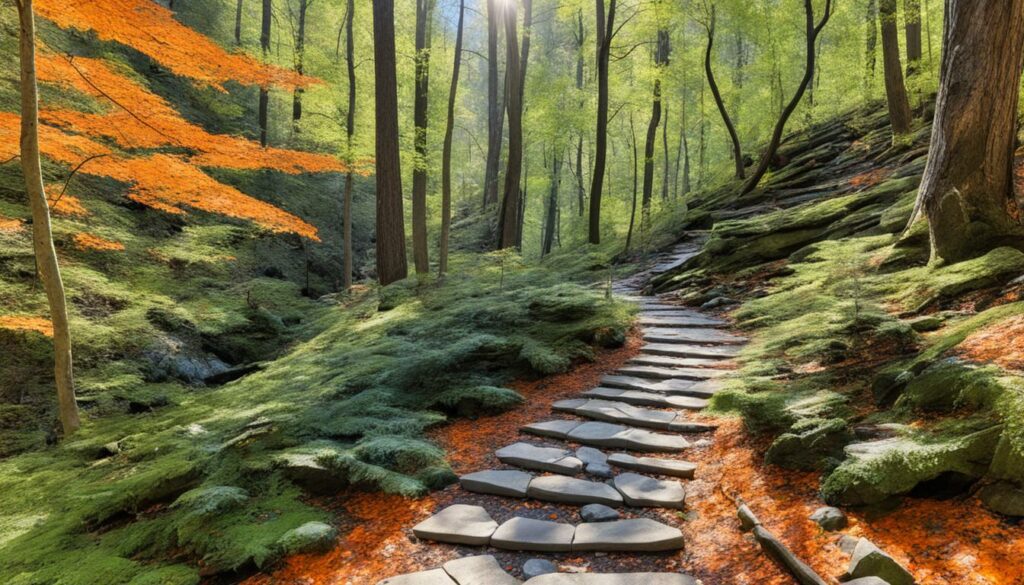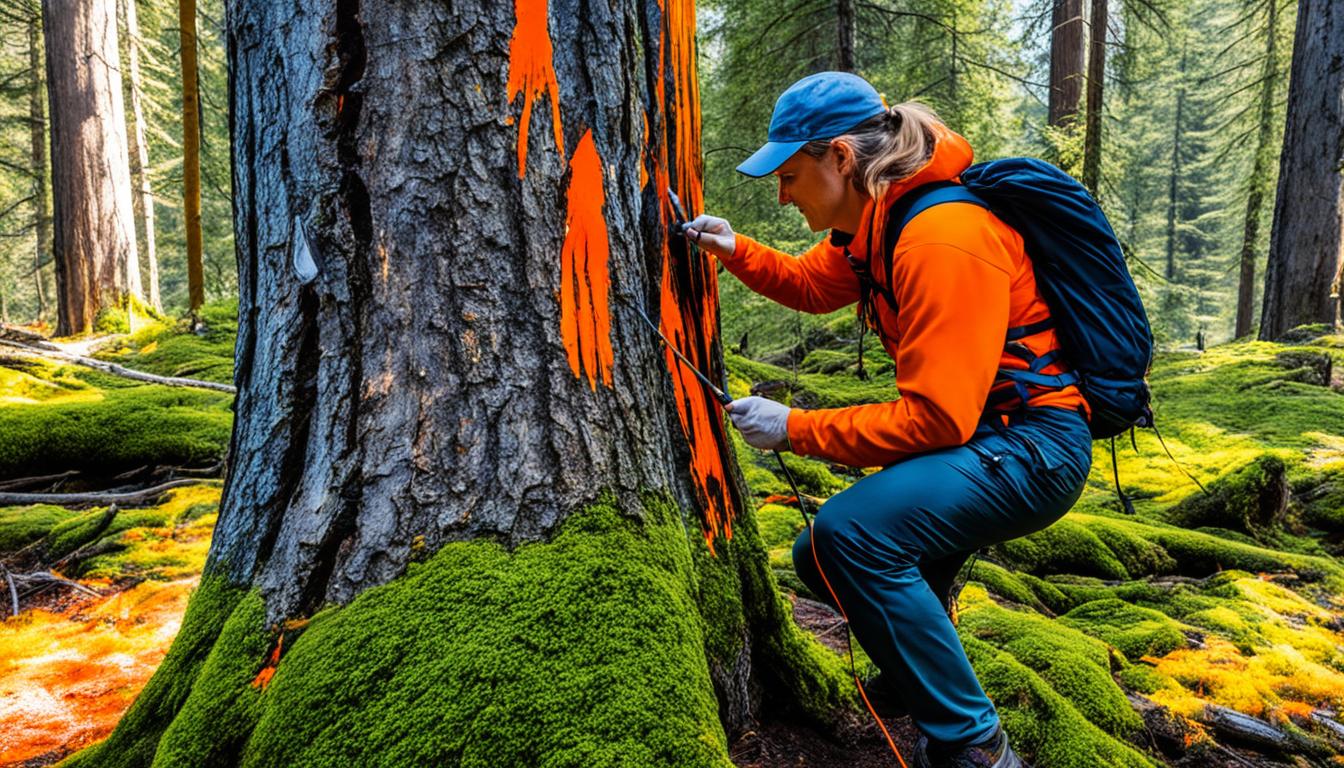How to Mark Trails Safely and Effectively in the Wilderness
Marking your path in the wilderness is essential for safe and confident navigation, especially for beginners. Whether you’re hiking deep into the backcountry or exploring an unfamiliar trail, knowing how to mark your route helps prevent getting lost and ensures a safe return.
From natural methods like stacking rocks and arranging sticks to using flagging tape and eco-friendly paint, this beginner’s guide covers the most reliable and low-impact trail marking techniques.
With the right knowledge and preparation, you’ll be able to navigate wild terrain while minimizing harm to the environment.
Key Takeaways
- Marking trails is key for safe travel in the wild.
- Using rocks, cairns, and sticks is a good way to mark trails.
- When using paint or markers, think about how it affects nature.
- Choosing the right way to mark trails depends on the environment.
- Keeping trail signs up and updated is important for safety.
Introduction to Wilderness Trail Marking
Navigating the wilderness is exciting but also has challenges. Knowing how to mark trails and find your way is key. Trail marking is crucial for wilderness navigation and backcountry route finding. It keeps you safe and makes your adventures more fun.
Importance of Trail Marking in the Wilderness
Going off the main path can lead you astray and make you lost. Trail blazing methods and natural trail markers act like a map. They guide you and help you find your way back. Good trail marking can change a bad situation into a great adventure.
Overview of Trail Marking Techniques
There are many ways to mark and navigate wilderness trails. You can use rocks, cairns, or marks on trees and branches. Knowing these trail marking methods makes your outdoor trips better and safer.
“Proper trail marking is essential for navigating the wilderness and ensuring the safety of outdoor enthusiasts.”
Preparing for Your Wilderness Adventure
Get ready for your wilderness adventure with the right gear and safety steps. Having the right trail marking tools and navigation gear is key. It can make your trip safe and fun.
Essential Gear for Trail Marking
When you go outside, you need the right essential gear for trail marking. This means compasses, map cases, flagging tape, and trail markers. These tools help you mark your path. They make sure you can find your way back and guide others.
Safety Considerations
Don’t forget your wilderness survival kit and safety tips for hiking. Always check the weather, tell others where you’re going, and know the dangers. This way, you can enjoy your adventure safely.
| Essential Gear | Safety Considerations |
|---|---|
|
|
Preparing well for your wilderness adventure is key to a safe and fun trip. With the right backcountry navigation equipment and safety tips, you can enjoy the outdoors. You’ll make memories that last a lifetime.
Natural Trail Marking Techniques
When you’re in the backcountry, using natural trail marking techniques is a great way to navigate. These methods are kind to the environment and keep the wilderness looking beautiful. Let’s look at two ways to mark trails naturally: with rocks and cairns, and with sticks and branches.
Using Rocks and Cairns
Using rocks and cairns is a simple way to mark trails. Cairns are stacks of rocks that act as landmarks. They help hikers in places where there are no other signs. Make sure to use rocks from the area and build cairns that look like they belong.
Placing single rocks along the trail can also keep hikers on track. This primitive navigation method is great for areas with little vegetation or rocky terrain.
Marking with Sticks and Branches
Using sticks and branches is another way to mark trails naturally. You can tie them together or arrange them in a pattern. This makes the trail easy to follow and keeps the area looking natural.
Remember to only use sticks and branches that are already on the ground. This way, you won’t harm the environment. Make sure to leave no trace of your markers when you’re done.
Wilderness Trail Marking Techniques
Outdoor lovers have many ways to mark trails in the wild. They use paint, markers, flagging tape, and signs. These methods help with safe and easy backcountry travel.
Blazing Trails with Paint or Markers
Paint or markers on rocks, trees, or ground make clear trail marks. This is great when nature signs are hard to see. Choose outdoor paints or markers that are safe for the environment.
Flagging Tape and Specialized Signage
Use bright flagging tape on branches or stakes to mark trails. It’s simple and can be changed easily. Custom signs or plaques give more info and help hikers stay on track.
| Technique | Advantages | Disadvantages |
|---|---|---|
| Paint or Markers |
|
|
| Flagging Tape |
|
|
| Signage |
|
|
Outdoor folks have many ways to mark trails in the wild. Knowing the good and bad of each method helps hikers and backpackers. This way, they can have a safe and fun time in nature.

“Proper trail marking is essential for safe and responsible navigation in the wilderness. It helps hikers stay on course, avoid getting lost, and minimize their impact on the environment.”
Blazing Trails with Paint or Markers
Marking wilderness trails with paint or markers is a popular method. It helps guide hikers and outdoor lovers. But, it’s important to pick the right materials and use them right. This makes sure the marks are seen, last long, and don’t harm the environment.
Choosing the Right Paint or Markers
Choosing the right paint or markers is key. Look for outdoor-use products that stand up to the weather. Use bright colors like fluorescent orange, yellow, or white. Stay away from paints with harmful chemicals to protect nature.
Trail markers made of metal or plastic work well too. They can be put on trees, rocks, or posts. Think about size, visibility, and how long they last when picking markers.
Proper Blazing Techniques
With the right materials, it’s time to blaze the trail. Apply paint or markers in a way that’s clear and easy to see. This helps hikers without harming the environment.
- Put marks at eye level, 5-6 feet high, so they’re easy to see.
- Mark every 50-100 yards to keep the trail clear.
- Use the same pattern, like vertical lines or squares, all along the trail.
- Don’t put too much on or do it randomly, as it can mess up the look of nature.
By doing this, you make trails that are easy to follow and protect nature at the same time.
Trail Marking for Different Environments
Navigating the wilderness is exciting but needs careful planning. Trail marking changes with the environment. In forests and deserts, knowing how to mark trails is key to keeping them visible and useful.
Marking Trails in Forests
Forests have lots of plants and changing ground that can hide trails. To stay on track, use natural and man-made signs. Cairns, blazed trees, and color-coded flags help guide hikers through the greenery.
Marking Trails in Deserts
Deserts are tough for finding your way. Sand and little plants can quickly hide trails. Using strong, weather-proof signs like reflective markers or stone cairns helps hikers cross the vast, sandy areas.
It’s important to adjust your trail marking for the environment. Knowing the challenges and using the right methods keeps adventures safe and fun.
| Environment | Trail Marking Techniques |
|---|---|
| Forests |
|
| Deserts |
|

Maintaining and Updating Trail Markings
Keeping wilderness trails marked is an ongoing job, not just a one-time task. To keep trails clear and easy to follow, you need to maintain and update them regularly. By monitoring trail conditions, fixing problems, and repairing and refreshing trail markers, you can keep trails in great shape.
Monitoring Trail Conditions
Checking your trails often is key to keeping them marked well. Look for signs of damage or things that could hide the trail. Check markers, cairns, and signs often. If you see any that are gone, faded, or hidden, fix them quickly.
Repairing and Refreshing Trail Markings
If you find problems on your trail checks, fix them right away. Repairing and refreshing trail markers keeps trails clear and welcoming for hikers. This might mean painting over old signs, rebuilding cairns, or cutting back overgrown plants. Keeping your trail markers in good shape helps hikers find their way, even in remote areas.
| Maintenance Task | Frequency | Tools Needed |
|---|---|---|
| Monitoring Trail Conditions | Quarterly |
|
| Repairing Trail Markers | Biannually |
|
By being careful and quick to act, you can keep your trails marked and easy to follow. This hard work makes the outdoors better for everyone who loves to explore it.
Leave No Trace Principles
When we mark trails in the wilderness, we must follow Leave No Trace principles. This keeps our impact on nature small. It helps protect the natural world and keeps the wilderness experience special for everyone.
Minimizing Environmental Impact
Using things like natural twigs or stones to mark trails is key. It cuts down on visual pollution and makes sure the marks break down safely. It’s also vital not to mark too much, so nature stays beautiful.
Responsible Trail Marking Practices
Working with land managers and following local rules is important for marking trails. Trail markers should follow the rules to help protect nature. This way, they can enjoy the outdoors without harming the environment.
FAQ
What is the importance of wilderness trail marking?
What are the essential gear and safety considerations for wilderness trail marking?
How can natural elements be used to mark wilderness trails?
What are the different techniques for marking wilderness trails?
How do you choose the right paint or markers for trail blazing?
How do you adapt trail marking techniques for different environments?
How do you maintain and update wilderness trail markings?
How can you ensure you’re following Leave No Trace principles when marking wilderness trails?
Source Links
- How to Navigate the Wilderness Like a Boss — Miss Adventure Pants – https://missadventurepants.com/blog/wilderness-navigation-techniques
- < Hiking tips for beginners – https://www.npr.org/transcripts/1196979748
- A Beginner’s Guide to Hiking – https://www.anordinaryexistence.com/beginners-guide-hiking/
